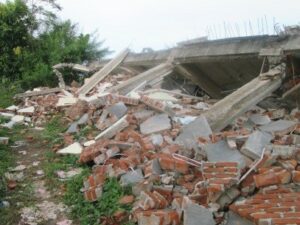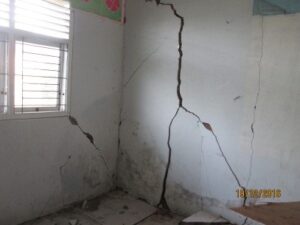Damages from the Pide Jaya Earthquake Day 1: Bieruen District
Build Change
Author
Our reconnaissance team is composed of 3 Build Change staff and our driver Danu. Danny is the technical team leader for our current better brickmaking program in Lubuk Alung, West Sumatera. She also led the technical team in our previous technical assistance program in Aceh Tengah in 2015. Elwahyudi is a technical supervisor who is also currently involved in the better brickmaking program with Danny.
We left Sunday at noon from Padang and flew to Medan. We then drove for about 10 hours to Bireuen, one of the three districts that were affected by the earthquake on December 6th in Pidie Jaya. There is no damage in the city and we saw no wood framed buildings. We went directly to Samalanga sub-district, the most affected part of the district, which is about 1 hour from the city. Here, we started to observe several wood framed building types, although confined masonry buildings are still dominant.
We met the Head of BPBD Bireuen and received information on specific villages that have a lot of damaged houses. Two people were killed in Bireuen, caused by cabinet and boards that collapsed on them.


We visited three schools in Bireuen, two of them are side by side and show little damage. The third was three-story religious boarding school (school-pesantren). All the three schools are masonry buildings. The third school we saw has sustained more damage as the column and beam are separated. Unfortunately, they lost one of their teachers during the earthquake. No timber framed school buildings were found in Bireuen.
We then visited Glumpang Bungkok, the most affected village in Bireuen where BPBD reported there are 76 damaged houses (15 of them are heavily damaged). There are 77 resident families in this village. When we arrived, we did not immediately see damaged houses, as several of them are badly damaged inside. Around 70% are confined masonry houses in that village, while others are timber frame with wood wall panel and timber frame with infill masonry. We also found several houses with timber frame upper levels and confined masonry at ground level. Generally, the timber frame ones were constructed much earlier (30-40 years ago) and then the confined masonry was added below at a later stage (10-15 years ago).


Most of the damaged houses, about 90% of them, are confined masonry, although we also observed the timber columns of some timber framed houses shifted from their footing. All houses use CGI roof and timber roof framing. In total we assessed 11 houses, 3 of which are badly damaged. We also interviewed some homeowners, builders, and the village leader (Kecik). Building material such as sand and gravel are widely available since they said they can take them from the river nearby. But for bricks, cement, and other manufactured materials, homeowners need to order from the city which is about 2 hours away. The area is luckily not a tsunami-zone. The Kecik is unsure when reconstruction will begin, as they are still waiting for government’s subsidy.

At 5 pm we headed to Pidie District (Sigli). Pidie Jaya District is the most affected area is between Bireuen and Pidie. As we left the Bireuen area, we immediately began to see more badly damaged houses and buildings. We stopped at one open space where we learned that the building that had once stood there had collapsed during the earthquake and killed 9 people.


We visited another heavily damaged school in Pidie Jaya District. It is comprised of 4 buildings, all of which are confined masonry, and one building is two stories. There are a lot of structural damages including cracked walls and floors, but no collapse except for ceiling and lighting fixtures. The school is just around 2 km from the coast line and is located in a tsunami-zone.
The emergency response period has been extended until December 27th.

We spoke to Muhammad Abdul Karim, whose house in Gumplang Bungkok village was highly damaged during earthquake. He, his wife, and their three children were asleep in one bedroom when they started to feel the shaking. Abdul was frightened- not only was the shaking was so bad that they couldn’t stand, but he also heard loud noises like things were crashing and collapsing outside their bedroom. He thought that day would be his last. He and his family just kept hugging each other. Fortunately, they were able to go out of the house safely after the temblors stopped after about a minute. Abdul got a minor injury on his leg, stumbling through the collapsed bricks. Around 70% wall of their brick house collapsed. The wood roof structure, however, is still fine. Currently, 13 days after earthquake, he and his family still do not dare sleep inside. Now, they live in their family’s house in the same village. He and his family only return to their house in the daylight. He has started to install some used wooden panels to replace the brick walls that collapsed. Abdul remains unsure about when he will have courage to stay in his house again and start to build his home back.
Support resilient housing worldwide
Join us in preventing housing loss caused by disasters.
Donate nowNewsletter
Sign up for our newsletter to receive updates on our latest news, events, and more.